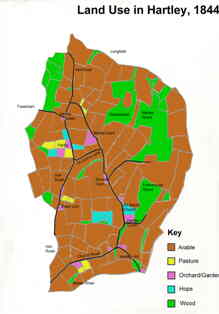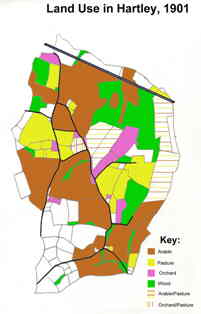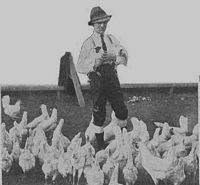|
Early history
The earliest evidence of
agriculture in Hartley dates back to Roman times. A farmhouse of
1st/2nd century AD date was discovered when the Wellfield Estate
was being built. Bones of pigs, sheep and cattle were found in a
ditch.
Middle Ages
From the Domesday Book we
learn that the village had a cultivated area of 600 acres and
"wood for10 pigs". It is clear from place name evidence
that the land in this area had to be won by the new settlers. The
"ley" element in Hartley, Idleigh and Ridley suggests
clearance of land, as did the names of some of Hartley's fields.
We can gain a glimpse of
the crops grown in Hartley in 1296, because the taxes in that
year were paid in corn, to be taken to the king's army in Gascony.
The collectors received 18 bushels of wheat and 4 bushels of oats
from Hartley. A reflection of the predominance of wheat locally (historically
people have always preferred wheat bread to that of any other
grain).
The first detailed
description of farming is a survey in 1392 of the lands owned by the
manor (Hartley Court). The picture is one of mixed
farming with an emphasis on arable. It mentions 206 acres of
arable land, 5 acres of grass for hay, an orchard, garden and
pasture land. Wheat is likely to have been the main crop.
This survey also suggests that Hartley once had two open fields: (1) The Rede, which probably included all the land between Ash Road and Church Road; and (2) Northfield, which appears to have lain to the north of Church Road and Manor Lane. Kentish open fields were not like the so called "classic" open field system, for it is believed that the farms owned blocks not strips and that they were subdivided by temporary brushwood enclosures (mentioned in a 14th century survey of Hartley manor). It is certainly striking how most of Hartley's farms owned land on both sides of Church Road, with the exceptions of Hartley Wood Farm and Fairby, both on the edge of the manor.
Early Modern Period
What evidence there is
suggests that mixed farming (weighted towards arable) continued
up to the last century. In a court case in 1560 William Middleton,
the tenant of possibly Hartley Wood Farm said he had planted 60
acres with wheat, barley, oats, beans, peas and tares. This suggests quite
heavy cropping, as the farm was only 100 acres in size.
Three
probate inventories from the 1600s give a good impression of
farming then, Thomas Young's farm at Fairby was 140 acres in size, with 80 acres
devoted to arable. By 1852
the amount of land given over to arable at Fairby had increased
to 104 acres.
Henry Middleton (?Hartley
Wood Farm, 1666): Wheat (51 acres); barley (17a); oats (18a);
peas (15a); grey peas (11a); "pease more" (8a); 10
horses, 10 pigs, 4 cattle, 76 sheep.
Thomas Young (Fairby,
1688): Wheat (35a); barley & oats (28a); peas and tares (17½a);
clover and sainfoin for mowing; 38 sheep; 12 cattle; 4 pigs; 8
horses.
James Burrow (New
House Farm, 1695 - part of?): wheat in fields and in barn; also
barley & peas, 6 cattle, 5 sheep, 4 pigs, 1 horse.
The greater
preponderence of sheep is characteristic of the waterless chalk
area. Figures
from Australia show that sheep can get by on as little as 2
litres (½ gallon) of water a day, although ewes with lambs
need 4-10 litres (1-2½ gallons). Young cattle need
a minimum of 25 litres (5½ gallons), and milk cows require
40-100 litres (10-25 gallons) - ten times the water requirements
of a sheep.
Some
clues to farming can also be gleaned from field names. Where
Chantry Avenue is today was once two large fields called Rye Croft.
Also New House Farm had a field called Sainfoin.
19th Century
The Agricultural
Magazine of 1804 contains a 5 page description of the state
of farming in Kent. The author praises the northern part of
the county for following the best modern farming practices. He
notes that the county is especially noted for hops, beans (for fodder),
and, in the area nearest London, potatoes.
At the time of the Tithe
survey in 1844, the age of "high farming", arable
predominates. The acreages devoted to each crop were:
|
Crop
|
Acreage
|
Yield
bushels/acre
|
Yield - tonnes/hectare
(2006
figures in brackets)
|
|
Wheat
|
222
|
22 bushels
|
1.48 (8.0)
|
|
Beans & Peas
|
110
|
20 bushels
|
1.35 (3.3)
|
|
Oats
|
94
|
32 bushels
|
2.16 (6.0)
|
|
Barley
|
43
|
28 bushels
|
1.89 (5.9)
|
|
Tares?
|
38
|
16 bushels
|
1.08
|
|
Seeds
|
103
|
|
|
|
Turnips
|
83
|
|
|
|
Tares
|
76
|
|
|
|
Fallow
|
37
|
|
|
|
Wood
|
208
|
|
|
|
Hops
|
22½
|
|
|
|
Pasture
|
20
|
|
|
|
Orchard
|
13
|
|
|
The 1844 figures for tonnes/hectare
are not exact, as the bushel was a measure of volume. To convert
this the current US equivalent of 60lbs per bushel is used. But
they do show the fantastic advances in crop yields over the last
150 years.
The parish also had 9 ploughteams of
4 horses each.
The high
farming period continued until the 1870s when a
nationwide depression set in. Like elsewhere Hartley's
farmers responded by increasing land devoted to pasture and
orchards, reflected in the 1901 land use map. From the annual farm
statistics, we can see that permanent grass for pasture increased
5 fold between 1867 and 1897. Hops were grown on
a smallish scale until the 1890s, as well as the Fairby Oast
House, New House Farm had a hop kiln.


Click on image for larger versions of land use maps of Hartley
The 19th century saw great advances
in mechanisation, although its extent in Hartley is little known.
As early as 1862, the Illustrated
London News was reporting on a demonstration of 11 steam ploughs
at Farningham. One engine achieved 5½ acres in five
hours, traditionally an acre is the amount one plough team can plough
in a day.
20th Century
The first decades
of the 20th century saw changes that were fundamental to the future
of farming in Hartley. The coming of mains water in 1901 seems
to have encouraged farmers to breed more cattle. In 1897 Hartley
had 36 cattle and 552 sheep, but in 1907 the figures were 109 cattle
and only 295 sheep (see farm
statistics).
The sale of land in smallholdings by Smallowners Ltd from
1911 led to a big increase in Orchard and small fruit production, as well as
poultry.
 A Hartley poultry farmer (1915)
A Hartley poultry farmer (1915)
Between the wars there was
a massive decline in arable acreage - the result of the lowest
grain prices for 150 years, by 1937 arable crops covered just 25
acres. The war years saw this trend reversed as farmers were encouraged
to plough up grass fields and to plant crops previously imported
(eg. 3½a of sugar beet in 1944). There were new sources of
labour too - land army girls and prisoners of war.
Since the war much land has
been lost to housing, most notably when New House Farm (which was
good agricultural land) was lost to New Ash Green. At the turn of
the century, about 900 acres were cultivated, but now there are
little more than 250 acres in farming.
In 1987 there were 11agricultural holdings in the parish, but only Hartley Bottom Farm and Thamesview Farm are of any size.
|